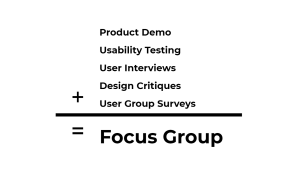
Introduction:
Focus groups, a moderated conversation with a group of participants, are a valuable method for UX researchers to delve into attitudes, beliefs, and perceptions. Unlike interviews, the power of focus groups lies in group discussions and interactions among members. This article will explore the concept of focus groups, their applications in UX research, potential drawbacks, and how to mitigate common problems. Learn how to conduct effective focus groups, analyze the data, and share your findings to make informed decisions in product development.
What is a Focus Group?
A focus group involves 5 to 10 participants engaged in a conversation moderated by a researcher on a specific topic. It is an effective tool for learning about user attitudes, desires, and reactions to concepts or designs. The social dimension of focus groups often uncovers spontaneous reactions and ideas that might be missed in one-on-one interviews. Researchers use them to understand group dynamics and gain insights into product feedback or brand perceptions.
Why Some User Researchers Hate Focus Groups?
Focus groups have their detractors due to certain drawbacks and potential pitfalls:
- Focus groups reveal what people say, not what they do, leading to discrepancies between stated intent and actual behavior.
- Groupthink can arise in focus groups, as participants tend to conform to the opinions of the group, providing a skewed understanding of individual experiences.
- Dominant personalities in a group can overshadow others, inhibiting the contributions of quieter participants.
- Effective moderation requires skill and experience, as group dynamics can be unpredictable and challenging to manage.

When to Use Focus Groups for UX Research:
Focus groups are best used to uncover perceptions, beliefs, and opinions rather than behaviors. They are valuable in the following scenarios:
- Identifying research questions during the early stages of a project.
- Exploring how people discuss problems, products, or shared experiences in a group setting.
- Gathering opinions, attitudes, and preferences after users interact with a prototype.
Conducting a Focus Group:
To conduct an effective focus group, follow these steps:
- Define your research goals and questions.
- Choose the location and decide on in-person or online focus groups.
- Select an experienced moderator to lead the discussions.
- Recruit participants who align with your research goals.
- Decide the number of groups and participants needed for your study.
- Obtain informed consent from participants.
- Offer appropriate incentives for participants’ time and expertise.

Analyzing Focus Group Data:
Focus group data analysis involves reviewing session notes, recordings, and artifacts. Use qualitative coding to tag and organize data into themes or categories. Analyze patterns and key insights to create a report focused on meeting the study’s research goals.
Sharing Your Findings:
When sharing your focus group findings, keep the deliverables focused on key insights, themes, and takeaways relevant to the research goals. Use video clips, key quotes, and participant-made artifacts to contextualize the information for stakeholders.
Conclusion:
Mastering focus groups in UX research requires careful planning, skilled moderation, and thoughtful analysis. By understanding their strengths and limitations, researchers can harness the power of focus groups to gain valuable insights into user perceptions and inform product development decisions. With the right approach, focus groups become an indispensable tool in the UX researcher’s toolkit.










